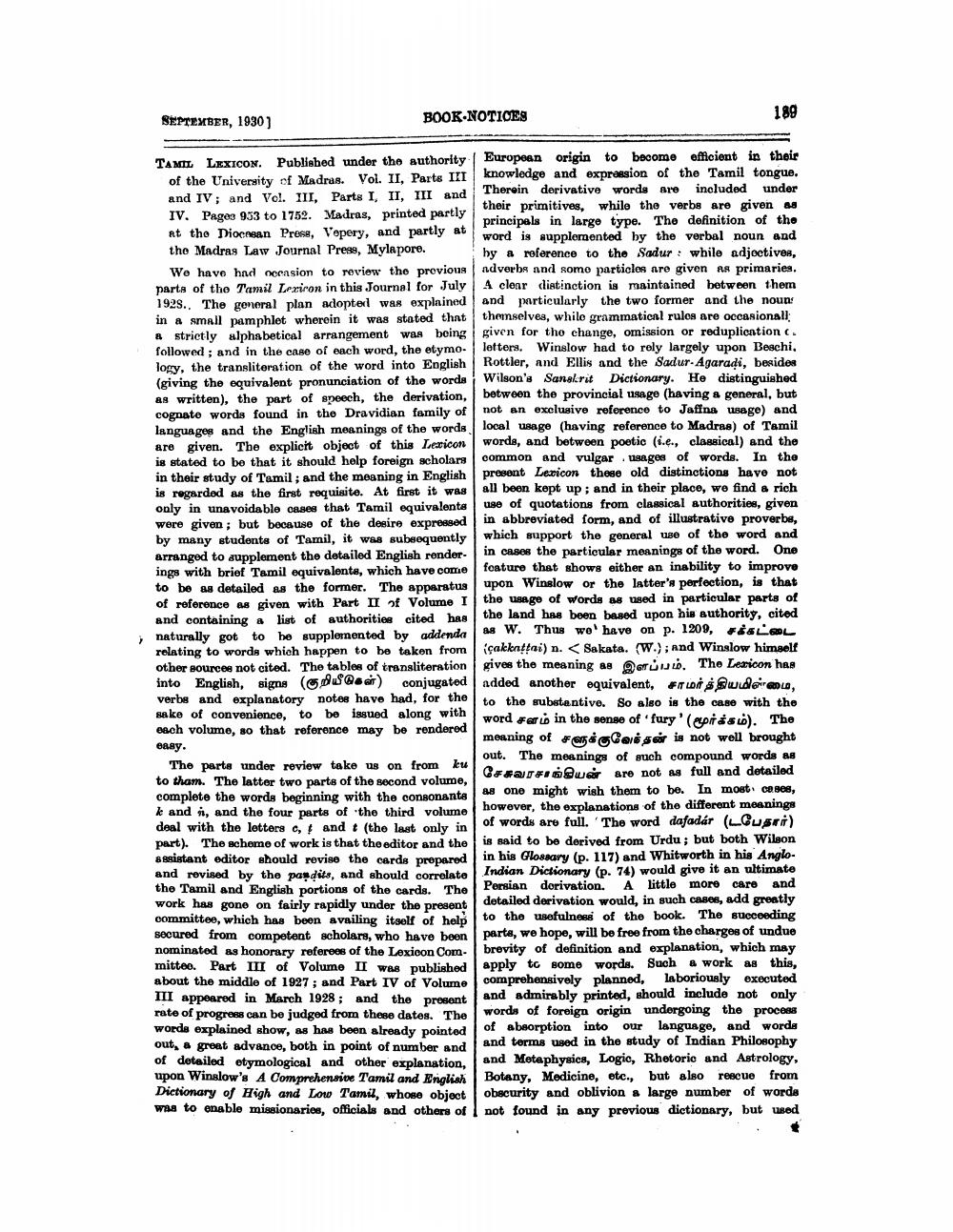________________
SEPTEMBER, 1930)
BOOK-NOTICES
189
TAMIL LEXICON. Published under the authority European origin to become officient in their
of the University of Madras. Vol. II, Parte III knowledge and expression of the Tamil tongue. and IV; and Vol. III, Parts I, II, III and Therein derivative words are included under IV. Pages 953 to 1752. Madras, printed partly
their primitives, while the verbs are given as
principals in large type. The definition of the At the Diocnean Prese, Vopery, and partly at
word is supplemented by the verbal noun and the Madras Law Journal Press, Mylapore.
hy a roference to the Sadur: whilo adjoetives, We have had occasion to review the provious adverbs and somo particles are given as primaries, parts of the Tamil Leriron in this Journal for July A clear distinction is maintained between them 1928.. The general plan adoptel was explained and particularly the two former and the noun: in a small pamphlet wherein it was stated that themselves, while grammatical rulos are occasionall # strictly alphabetical arrangement was being given for tho change, omission or reduplication . followed ; and in the case of each word, the etymo letters. Winslow had to rely largely upon Beschi, logy, the transliteration of the word into English Rottler, and Ellis and the Sadur. Agaradi, besides (giving the equivalent pronunciation of the words Wilson's Sanskrit Dictionary. He distinguished as written), the part of speech, the derivation, between the provincial usage (having a general, but cognato words found in the Dravidian family of not an exclusive reforence to Jaflna usage) and languages and the English meanings of the words local usage (having reference to Madrne) of Tamil are given. The explicit object of this Lexicon words, and between poetic (i.e., classical) and the is stated to be that it should help foreign scholars common and vulgar usages of words. In the in their study of Tamil ; and the meaning in English present Lexicon these old distinctions have not is regarded as the first requisite. At first it was all been kept up; and in their place, we find & rich only in unavoidable cases that Tamil equivalente use of quotations from classical authorities, given were given ; but because of the desire expressed in abbreviated form, and of illustrative proverbe, by many students of Tamil, it was subsequently which support the general use of the word and arranged to supplement the detailed English render in cases the particular meanings of the word. One ings with brief Tamil equivalente, which have come feature that shows either an inability to improve to be as detailed as the former. The apparatus upon Winslow or the latter's perfection, is that of reference as given with Part II of Volume I the usage of words as used in particular parts of and containing a list of authorities cited has the land has been based upon his authority, cited naturally got to be supplemented by addenda
as W. Thus we have on p. 1209, FÅELSL relating to words which happen to be taken from íçakknttai) n. < Sakata. W.); and Winslow himself other sources not cited. The tables of transliteration gives the meaning as Morun L. The Lericon has into English, signs ( @sar) conjugated added another equivalent. A
deren verbs and explanatory notes have had, for the to the substantive. So also is the case with the sake of convenience, to be issued along with
word சளம் in the sense of fury' (மூர்க்க ம்). The each volume, so that reference may be rendered easy.
meaning of Soloissa is not well brought The parts under review take us on from ku
out. The meanings of such compound words as to tham. The latter two parts of the second volume,
சேசுவரசங்கியன் are not as fall and detailed complete the words beginning with the consonante
as one might wish them to be. In most coses, k and it, and the four parts of the third volume
however, the explanations of the different meanings deal with the letters c, and + (the last only in
of words are full. The word dafadár (Lousri) part). The scheme of work is that the editor and the is said to be derived from Urdu; but both Wilson 8ssistant editor should revise the cards prepared in his Glossary (p. 117) and Whitworth in his Angloand revised by the pasdits, and should correlato
Indian Dictionary (p. 74) would give it an ultimate tho Tamil and English portions of the cards. The Persian dorivation. A little more care and work has gone on fairly rapidly under the present
detailed derivation would, in such cases, add greatly committee, which has been availing itself of help to the usefulness of the book. The succeeding secured from competent scholars, who have been
parts, we hope, will be free from the charges of undue nominated as honorary referees of the Lexicon Com- brovity of definition and explanation, which may mittee. Part III of Volume II was published apply to some words. Such a work as this, about the middle of 1927; and Part IV of Volume
comprehensively planned, laboriously executed M appeared in March 1928 ; and the prosent and admirably printou,
and admirably printed, should include not only rate of progress can be judged from these dates. The
words of foreign origin undergoing the process words explained show, as has been already pointed
of absorption into our language, and words out, a great advance, both in point of number and
and terms used in the study of Indian Philosophy of detailed etymological and other explanation,
and Metaphysics, Logic, Rhetoric and Astrology, upon Winslow's A Comprehensive Tamil and English Botany, Medicine, etc., but also rescue from Dictionary of High and Low Tamil, whose object obecurity and oblivion a large number of words was to enable missionaries, officials and others of not found in any previous dictionary, but used




